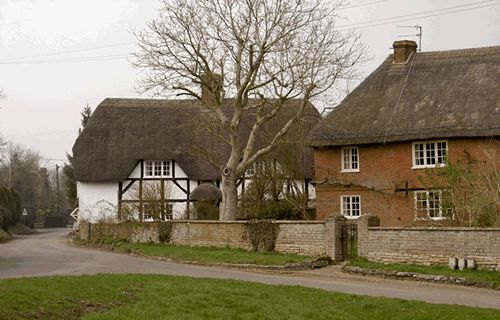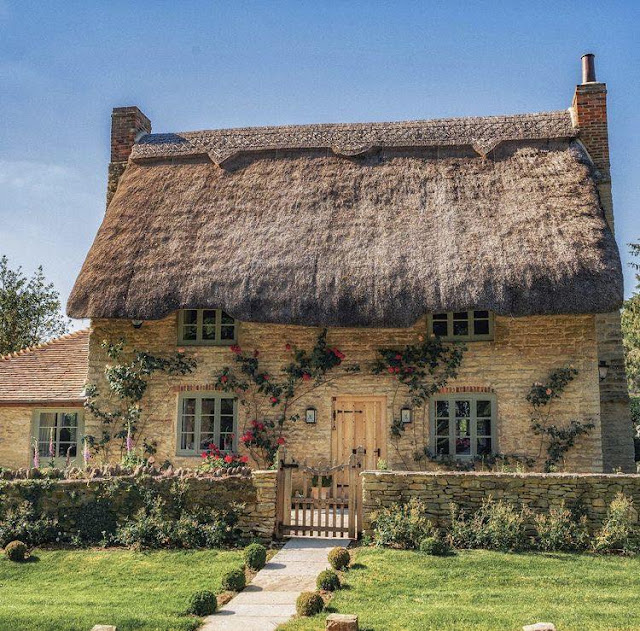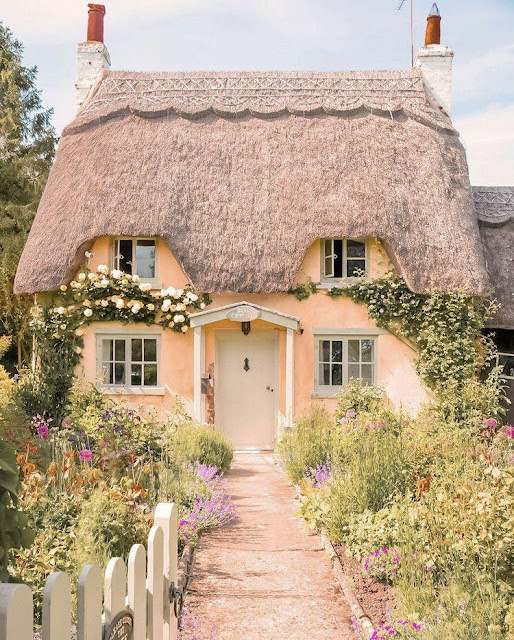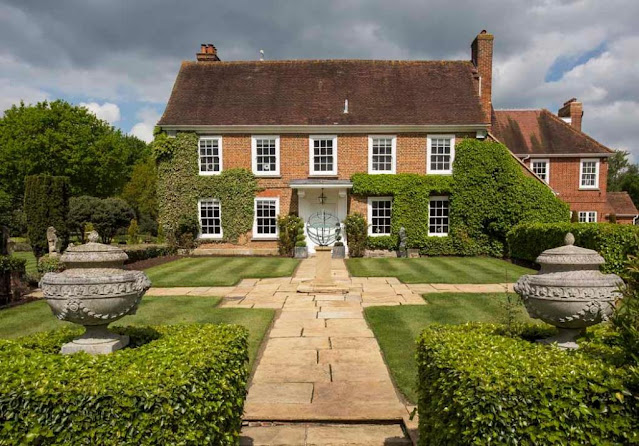Game, Set, Thatch!
Games, Set, Thatch!
The pretty English Country Cottage is recognised and dreamt of the world over and is without doubt that a thatched roof is an essential ingredient. But how much do you know about thatched roofs and the thatching process?
I have trawled the internet and collated a series of articles and information pieces which will provide an insight in to this fascinating process, and of course, one or two photographs of the prettiest thatched cottages I could find, not to mention a couple of fascinating videos!
It's not just in Great Britain that we find thatched roofs, examples of the practice can be found all over the world, as reported on Wikipedia...
The History of Thatched Roofs:
Thatching methods have traditionally been passed down from generation to generation, and numerous descriptions of the materials and methods used in Europe over the past three centuries survive in archives and early publications.
- Most thatched-roof houses in the British Isles are remnants of an earlier time, dating to the 19th century or even as far back as the 16th. But as 21st-century buyers build second homes in the countryside, they often choose to have the older, rustic look thatching gives. Modern homes and even garden gazebos are being thatched, and the style is becoming increasingly popular in North America.
- The most important part of the roof, and one of the trickiest to do right, is the ridge at the top. While on the main part of the roof the bundles of thatch are laid all in the same direction in orderly rows, here they are placed in opposite directions and folded over the ridgeline of the roof. As it takes the brunt of the weather it may need to be replaced every 10 years or so.
- The plants’ natural water resistance makes rain simply run off the roof. A wire mesh is placed over the whole roof to keep out birds and vermin. Rain is good for the straw because it replaces the plant’s natural moisture.
- Fire, the greatest concern of anyone thinking of buying a thatched home, is actually no more frequent with thatched roofs than normal ones. Once started, however, a burning thatched roof is much more difficult to put out. The main causes of fire are faulty wiring or badly constructed, or old, chimneys that release sparks that land on the roof. Chimneys should be properly built and maintained, and any wiring should be done by a licensed contractor.
Thatched roofs last around 30 years. The minute you lay one, it slowly starts to rot. Looking pretty isn't cheap. "I usually tell a customer they should be putting away £1,500 to £2,000 a year to cover it." Master thatcher, Glen Holloway, as interviewed by The Guardian's excellent article "How to Thatch a Roof"
The following information is from www.buildingconservation.com...
The predominant thatching material in use in this country up until the 19th Century was straw - either longstraw or combed wheat reed. Norfolk Reed (or water reed) was traditionally used in the counties of East Anglia and other wetland areas. A diversity of styles had developed over time and, coupled with different materials, distinct regional characteristics became apparent. The combed wheat reed roofs of the West Country for example, are shallow pitched and 'pudding basin' in appearance compared with the steeply pitched longstraw roofs of East Anglia. The treatment of ridges, eaves and gables varies in different parts of the country and in those areas where there is a strong thatching tradition a departure in style today would look out of place.In the early years of this century thatching was in decline. The commercial production of Welsh slate had begun in 1820 and the mobility which the canals and then the railways made possible meant that other materials became far more readily available than ever before. Use of the material declined following the First World War in particular, and with the invention of the combine harvester and the need to develop shorter stemmed varieties of wheat, the long straw once produced was no longer available.
With renewed interest in our historic architecture, thatching is now, once again, in the ascendancy. The three main thatching materials in use today are water reed (often known as Norfolk Reed although a large amount is imported from Eastern European countries), longstraw and combed wheat reed. Sedge, a grass-like plant which grows in wetland areas, is also used extensively in ridging.
WATER REEDWater reed is used extensively in parts of the West Country and East Anglia. New properties are almost always thatched in water reed since it is the most durable of the thatching materials, and tends to give the longest life. Many factors influence the longevity of a thatched roof and it is therefore unwise to generalise on the subject. However a Norfolk Reed roof situated in one of the counties of East Anglia where there is a tradition of very steep pitches, could be expected to last an average of 50-60 years although there are instances of roofs lasting much longer than this.
When re-thatching with water reed, the existing material will be completely removed back to the roof timbers, although in the south-west of the country, where roof pitches tend to be less steeply pitched, thatchers often lay water reed on top of a base coat. The new reed is carried on to the roof in bunches and, starting at eaves level, is fixed directly into the rafters with the butts of the stalks exposed. Each layer of reed is held in place with either steel or hazel sways and once in position it is dressed into shape with the use of a legget.
LONGSTRAW
Longstraw was once extensively used throughout the main corn crop regions from Dorset northwards, but is now confined mainly to the counties of East Anglia, although examples of it exist up and down the country. It is harvested with a binder. Old-fashioned long-stemmed varieties of wheat are grown and cut whilst still slightly green. After being allowed to dry, the wheat is threshed in a threshing drain and the resultant straw leaves the drum in a fairly mixed state.
Before longstraw can be used for thatching it needs to be made into yealms. A yealm can be described as a tight, compact layer of straw, which has been 'tidied' and is level at both ends. Yealming is a lengthy procedure which takes place on the ground and is basically carried out in order to straighten the straw and prepare it into manageable amounts for use on the roof.
 |
| Reed thatch (left), long straw (right) |
When re-thatching with longstraw, it is not usually necessary for all of the old material be removed from a roof. The thatcher will normally only remove existing material back to a base coat and the new straw is then fix to this with hazel spars.
COMBED WHEAT REED
Longstraw thatch is easily distinguishable from the other two types of material. It has long lengths of straw visible on the surface and has the general appearance of having been poured on, contrasting with the closely cropped look of combed wheat reed and water reed (see above). Longstraw also has exterior hazel rodding at eaves and gables - a feature seldom seen on the reed types. As it is more easily attacked by birds, netting is usually fitted to the whole of the roof.
Combed wheat reed, or 'Devon' reed is predominantly used in the south and west of the country. Although very similar in appearance to water reed, it is in fact straw. The grain is removed from the straw through a combing machine which is fitted to the top of an ordinary threshing drum. The straw does not then have to pass through the drum and comes from the machine with the butts all laid in one direction. It is then tied into bundles and stacked ready for use.Combed wheat reed is applied to the roof in a similar fashion to water reed, dressed into shape with a legget. However, as with longstraw, it is not necessary to remove all the existing material from a roof prior to re-thatching.
Although there are national average figures quoted for the longevity of each type of material, these are of little use as judgements on performance - or likely performance - can only be made in individual circumstances. The performance of thatch depends on many factors such as roof shape and design, the pitch and its position (geographically and topographically), the quality of the material and the skill of the thatcher.
RIDGES
The ridge of a thatched roof bears the brunt of the weather and, as the fixings are external, it requires attention on average every 10 to 15 years. The material used is usually the same as that used for the main coatwork, however, water reed is too stiff and brittle. As a result, the ridge of a water reed roof is often made with sedge.
The patterned ridges which have become popular allow the thatcher some artistic licence, but they are a relatively new innovation and as such are thought to be unsuitable for the majority of historic thatched properties. Different considerations apply in the re-thatching of an old building and one of recent date and it is probably fair to say that a house built prior to the 19th Century requires good plain workmanship without too much embellishment.
There are two main types of ridge - the 'wrap-over' which is used most widely, and the 'butt-up' which is found mainly in the south-west of the country where its use would appear to have developed from the stiffer nature of combed wheat reed. The 'butt-up' ridge has the butts of the material forced together from either side to form an apex whereas the 'wrap-over' is formed by folding a thick layer of material over the apex of the roof and fixing it on both sides.
PERFORMANCE
With greater awareness of the vernacular materials and style of particular regions, conservationists have realised the importance of maintaining (and even returning to) the historically correct thatching style and material pertinent to the area. Local authorities actively discourage the use of a 'foreign' material and in any case, listed building consent is required for alterations to a listed building. Furthermore, the awarding of grants for repairs and re-thatching is often dependent upon compliance with the thatching policy of the local council and consideration of a change of material will usually only be granted for exceptionally strong technical reasons.
A common misconception with thatch is the idea that it absorbs large amounts of water. This is not the case at all. Water is transferred down the roof from stem to stem until it drops from the eave. The steep pitches associated with thatched roofs allow for water to be shed at a very fast rate. When designing for thatch, ample allowance should be made for the projection of the eaves and gables to project water clear of the building, and the ground should be well drained.
When alterations to an existing thatched roof are planned or when designing a new thatched roof it is imperative that consultation with a Master Thatchers Association is sought and in the case of a listed building, with the conservation officer at the local council. Thatchers have no hesitation in recommending thatch as an ideal roof covering, provided that certain conditions are met. It is only those who work with the different materials and understand the complexities of thatch who are able to advise properly on the way thatch will work.
Back in 1973 this fascinating video was produced
"How To Thatch A Roof"
 |
| CLICK HERE to go to our other blog site |


















Comments
Post a Comment